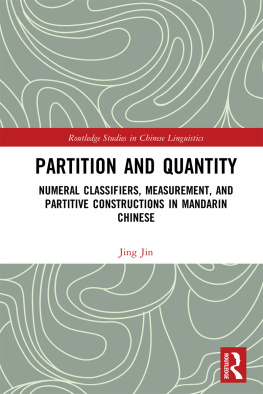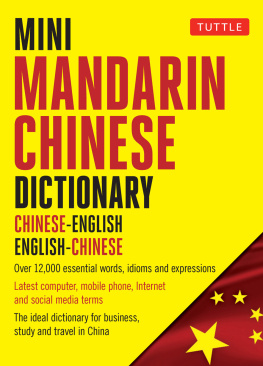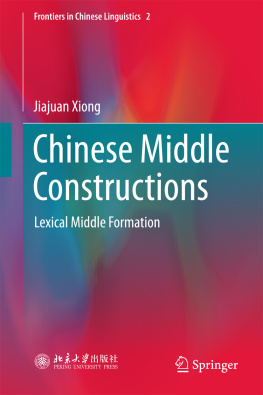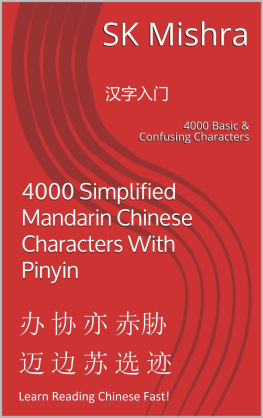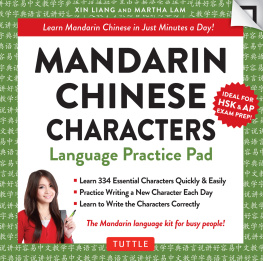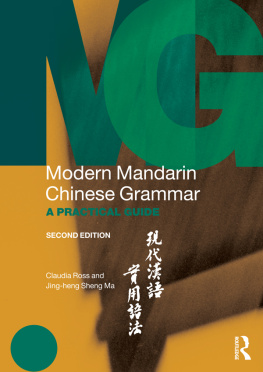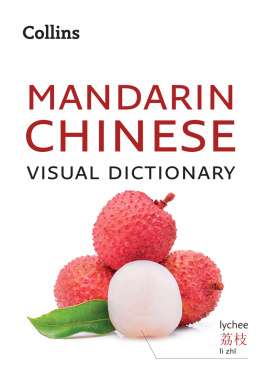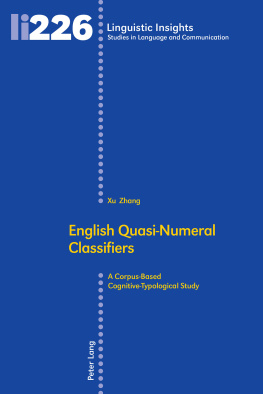
Partition and Quantity
Partition and Quantity: Numeral Classifiers, Measurement, and Partitive Constructions in Mandarin Chinese presents an in-depth investigation into the semantic and syntactic properties of Chinese classifiers, and conducts a comprehensive examination on the use of different quantity constructions in Chinese.
This book echoes a rapid development in the past decades in Chinese linguistics research within the generative framework on Chinese classifier phrases, an area that has emerged as one of the most cutting-edge themes in the field of Chinese linguistics.
The book on the one hand offers a closer scrutiny on empirical data and revisits some long-lasting research problems, such as the semantic factor bearing on the formation of Chinese numeral classifier constructions, the (non-)licensing of the linker de () in between the numeral classifier and the noun, and the conditions regulating the use of pre-classifier adjectives. On the other hand, particular attention is paid to the issues that have been less studied or gone unnoticed in previous studies, including a (more) fine-grained subcategorization of Chinese measurement constructions, the multiple grammatical roles played by the marker de () in different numeral classifier constructions, the formation and derivation of Chinese partitive constructions, etc.
Jing Jin is Assistant Professor in the Department of Chinese Language Studies at The Education University of Hong Kong. Her research interests lie in syntax, syntax-semantics interface, and Chinese linguistics.
Routledge Studies in Chinese Linguistics
Series editor: Hongming Zhang
Modern Chinese Grammar
A Clause-Pivot Approach
Fuyi Xing
Syntax-Phonology Interface
Argumentation from Tone Sandhi in Chinese Dialects
Hongming Zhang
Cognition-Based Studies on Chinese Grammar
Yulin Yuan, translated by Guoxiang Wu
The Interfaces of Chinese Syntax with Semantics and Pragmatics
Yicheng Wu
Dimensions of Variation in Written Chinese
Zheng-Sheng Zhang
The Semantics of Chinese Classifiers and Linguistic Relativity
Song Jiang
Mandarin Chinese Words and Parts of Speech
A Corpus-based Study
Chu-Ren Huang, Shu-Kai Hsieh, Keh-Jiann Chen
A Study of Sino-Korean Phonolgy
Its Origin, Adaptation and Layers
Youyong Qian
Partition and Quantity
Numeral Classifiers, Measurement, and Partitive Constructions in Mandarin Chinese
Jing Jin
First published 2019
by Routledge
2 Park Square, Milton Park, Abingdon, Oxon OX14 4RN
and by Routledge
711 Third Avenue, New York, NY 10017
Routledge is an imprint of the Taylor & Francis Group, an informa business
2019 Jing Jin
The right of Jing Jin to be identified as author of this work has been asserted by her in accordance with sections 77 and 78 of the Copyright, Designs and Patents Act 1988.
All rights reserved. No part of this book may be reprinted or reproduced or utilised in any form or by any electronic, mechanical, or other means, now known or hereafter invented, including photocopying and recording, or in any information storage or retrieval system, without permission in writing from the publishers.
Trademark notice: Product or corporate names may be trademarks or registered trademarks, and are used only for identification and explanation without intent to infringe.
British Library Cataloguing-in-Publication Data
A catalogue record for this book is available from the British Library
Library of Congress Cataloging-in-Publication Data
Names: Jin, Jing, 1986- author.
Title: Partition and quantity: numerical classifiers, measurement, and partitive constructions in Mandarin Chinese / Jing Jin.
Description: London; New York, NY: Routledge, 2018. | Series: Routledge studies in Chinese linguistics
Identifiers: LCCN 2018004079| ISBN 9781138182523 (hardback: alk. paper) | ISBN 9781315646428 (ebook)
Subjects: LCSH: Chinese languageSyntax. | Chinese languageClassifiers. | Classifiers (Linguistics)
Classification: LCC PL1241 .J55 2018 | DDC 495.15dc23
LC record available at https://lccn.loc.gov/2018004079
ISBN: 978-1-138-18252-3 (hbk)
ISBN: 978-1-315-64642-8 (ebk)
Typeset in Times New Roman
by Sunrise Setting Ltd., Brixham, UK
To my parents
Contents
| A, AP | Adjective, Adjective Phrase |
| BA | Marker of the disposal construction b () |
| BEI | Passive marker bi () |
| Cl, ClP | Classifier, Classifier Phrase |
| D, DP | Determiner, Determiner Phrase |
| DE | Prenominal modifier marker de (), focus marker de (), marker of DP-internal predicate inversion de (), or postverbal resultative marker de () |
| Dem, DemP | Demonstrative, Demonstrative Phrase |
| Dur | Durative aspectual marker zhe () |
| e | Empty category resulting from ellipsis |
| EvalP | Evaluative Phrase |
| Exp | Experiential aspectual marker gu () |
| FocP | Focus Phrase |
| IP | Inflectional Phrase |
| LF | Logic Form |
| LP | LINKER Phrase |
| ModP | Modifier phrase |
| MonP | Monotonic Phrase |
| MP | Measurement Phrase |
| N, NP | Noun, Noun Phrase |
| Num, NumP | Numeral, Numeral Phrase |
| Perf | Perfective aspectual marker le () |
| PF | Phonetic Form |
| PL | Plural |
| PP | Preposition Phrase |
| Q, QP | Quantifier, Quantifier Phrase |
| RP | RELATOR Phrase |
| SFP | Sentence final particle |
| SG | Singular |
| t | Trace resulting from syntactic movement |
| V, VP | Verb, Verb Phrase |
* Ungrammatical expression
# Grammatical but pragmatically unacceptable expression
? Grammatical and pragmatically marginally acceptable expression
This book is partially funded by the Department of Chinese Language Studies, The Education University of Hong Kong.
Classifiers have long been the subject of immense interest in linguistic investigations into Mandarin Chinese. Since the 1980s, this area has particularly attracted continuing scholarly attention, with various endeavors being made to provide a formal account of numeral classifier constructions in Chinese (Huang, 1982; Tang, 1990; Cheng and Sybesma, 1998, 1999, 2005; Y.-H. Li, 1998, 1999). In recent years, numeral classifier constructions have emerged as one of the most cutting-edge themes in the field of Chinese linguistics, triggering growing concerns and heated debates concerning topics ranging across the syntax/semantics of different types of classifiers, the underlying structure of classifier phrases, the referential properties of numeral classifier constructions, and so on (Pan and Hu, 2000; Tang, 2005; Hsieh, 2008; Wu and Bodomo, 2009; Zhang, 2009, 2013; Her and Hsieh, 2010; X.-P. Li, 2011, 2013; Pan and An, 2012).
This book aims to expand existing scholarly discussions about Chinese classifier expressions via a more in-depth investigation into the semantic and syntactic behaviors of Chinese numeral classifiers, and a more comprehensive examination of the use of different quantity constructions in Chinese. The following three main themes will be covered:
Next page
